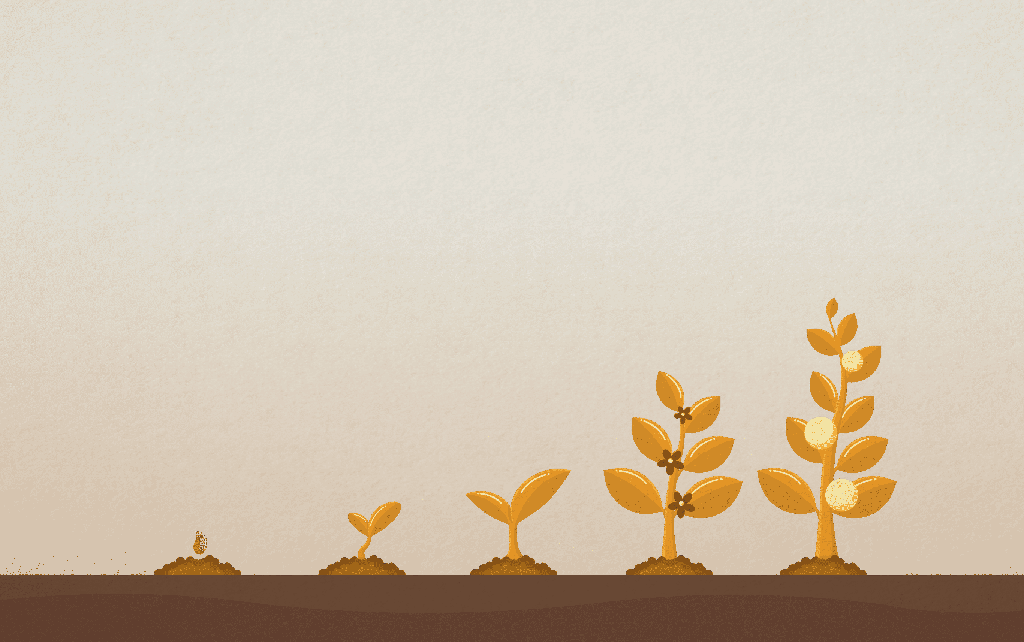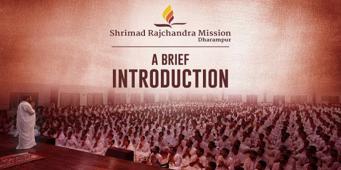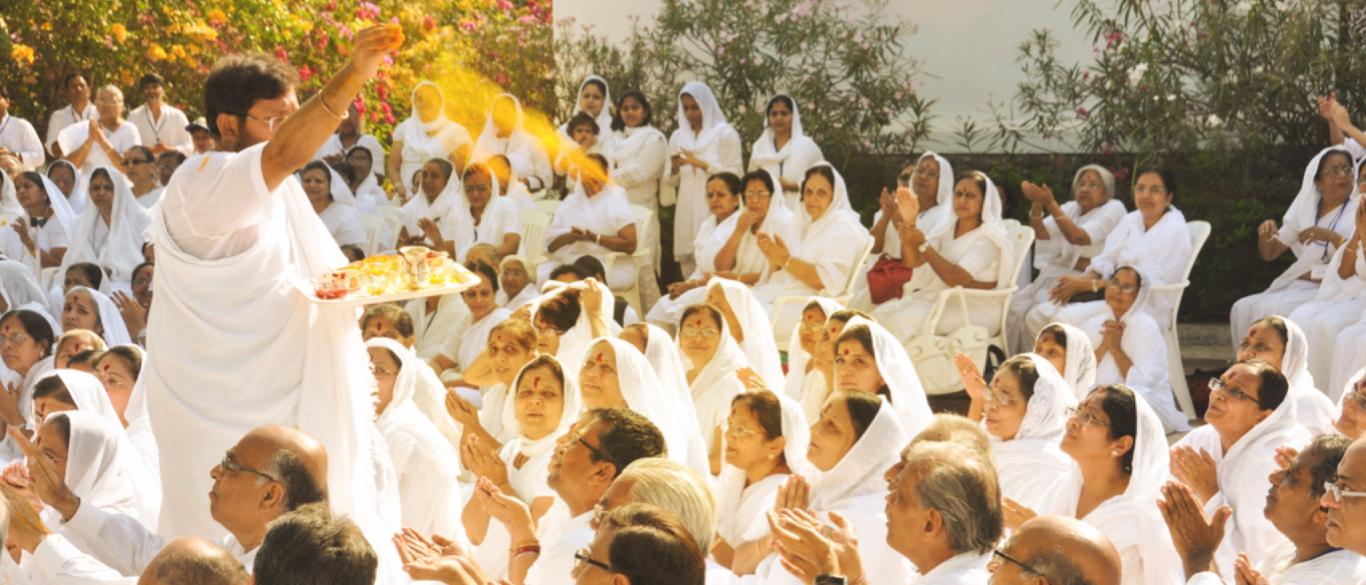
What is Panchdiksha?
Akin to a tiny seed that manifests into a magnificent tree, the Panchdiksha initiation is a five-level journey of spiritual progress set forth by Pujya Gurudevshri. Open to everyone, the vows and practices enable you in reaching full bloom.
What are the Five Levels?
Passionately follow the spiritual practices as prescribed by the Sadguru and safeguard it with the fence of vows, to develop, mature and attain liberation.
What are the Spiritual Practices?
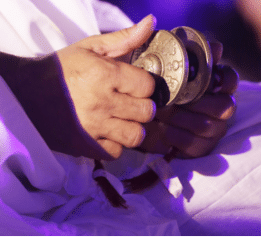
Bhakti
Dissolve in Devotion

Swadhyay – Satsang
Immerse in Wisdom

Vishesh Abhyas
Deepen your Practice

Dhyan
Melt in Meditation
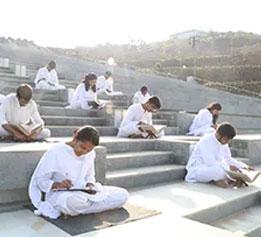
Anushthan
Slip into Silence

Nivrutti
Retreat into Yourself
The first four levels of the Panchdiksha Vikasyatra are given below. Further information on the fifth level or Falam Diksha will be declared by Pujya Gurudevshri in due course.
Panchdiksha Practice Details (Gujarati PDF)
Beejam – Mantra Diksha
Beejam
Mantra Diksha
Through Beejam Diksha you begin a new phase of your spiritual life. Get embedded securely with sacred mantras and recitation through a daily commitment.
Beejam Practice Details
Bhakti
- 3 Paath
- 3 Mala
- Pranipat Stuti
Download Ajnabhakti PDF:
Purchase Ajnabhakti Book:
Purchase Ajnabhakti MP3:
Swadhyay – Satsang
- 3 hours per fortnight
Avadhi (Duration)
- Lifelong
Eligibility
Abstinence from consuming non-vegetarian food and drugs for life
Prayashchit
- Besnu or 2 tunks

Ankuram – Dhyan Diksha
Ankuram
Dhyan Diksha
Experiencing the grace of the Sadguru, you begin to sprout spiritually. Ankuram Diksha initiates you into meditation, as you embark on the inner journey.
Ankuram Practice Details
Bhakti
- 3 Paath, 3 Mala, Pranipat Stuti
- Evening Devvandan
- Shri Atmasiddhi Shastra
Download Ajnabhakti PDF:
Purchase Ajnabhakti Book:
Purchase Ajnabhakti MP3:
Swadhyay – Satsang
- 3 hours in a week
Dhyan
- 15 minutes twice a day
Avadhi (Duration)
- Lifelong
Eligibility
Abstinence from consuming alcohol and smoking for life
Prayashchit
- Besnu or 2 tunks
- 11 times recitation of Kshamapna

Parnam – Nijabhyas Diksha
Parnam
Nijabhyas Diksha
As you mature on the spiritual path and become more focused, the Sadguru blesses you with higher commitments and practices for progressive development.
Parnam Practice Details
Bhakti
- Morning Ajnabhakti
- Evening Ajnabhakti
- Chaityavandan, Devvandan
Download Ajnabhakti PDF:
Purchase Ajnabhakti Book:
Purchase Ajnabhakti MP3:
Swadhyay – Satsang
- 7 hours in a week
Dhyan
- 45 minutes in 2 sittings everyday
- Two Sadhana Bhattis in a year, of which one must be a 3-day bhatti; the other may be done as:
- 1-day Bhatti 3 times, or
- 3-day Bhatti Once
Anushtthan
Everyday 3 samayiks or 3 hours maun
Vishesh Abhyas
One day in a week 12 hours maun (can be done in 2 parts) preferably with some tapa e.g. fruit day.
Avadhi (Duration)
- If lifelong – then ‘Dikshit’ (Initiated)
- If for 1 year – then ‘Abhyasi’ (In practice)
Eligibility
Abstinence from eating root vegetables (kandmul) for life
Read the Vachanamrutji minimum once
Prayashchit
- Besnu or 2 tunks
- 11 times recitation of Kshamapna
- 500 written japas of the mantra – ‘Sahajatmaswaroop Paramguru’.

Pushpam – Vanprastha Diksha
Pushpam
Vanprastha Diksha
Vanprastha diksha is handing over the reins of the household and business, and gradually withdrawing from worldly activities. It is a committed step in the direction of self-realisation.
Pushpam Practice Details
Bhakti
- Morning Ajnabhakti
- Evening Ajnabhakti
- Chaityavandan, Devvandan
Download Ajnabhakti PDF:
Purchase Ajnabhakti Book:
Purchase Ajnabhakti MP3:
Swadhyay – Satsang
- 2 hours daily
Dhyan
- 1 hour daily
- Three Sadhana Bhattis in a year; of which 1 must be a 3-day Bhatti; the other 6 days may be done as:
- 1-day Bhatti 6 times, or
- 3-day Bhatti twice, or
- 3-day Bhatti once and 1-day Bhatti thrice.
Anushtthan
Everyday 4 samayiks or 4 hours maun
Vishesh Abhyas
One day in a week 12 hours maun preferably with some tapa e.g. fruit day.
Nivrutti
- Minimum 125 days stay in nivrutti kshetra
- Minimum 9 hours of sadhana-seva during nivrutti days
During nivrutti days:
- Observe complete celibacy
- Abstinence from business activity
Avadhi (Duration)
- If lifelong – then ‘Dikshit’ (Initiated)
- If for 1 year – then ‘Abhyasi’ (In practice)
Eligibility
(For lifelong Diksha)
Abstinence from eating after sunset for life (Can take exemption of liquids and medicines)
Vanprastha Abhyas for minimum one year
Read the Vachanamrutji minimum twice
What is the Code of Conduct for Vanprastha Diksha?
Spiritual Eligibility
1. Retreats:
- Spiritual retreats of minimum 125 days in a year. (It does not have to be 125 days at one stretch).
- These 125 days can include stay in the Ashram, yatras, Paryushan Parva etc. – retreats taken for sadhana and seva.
- In case of an unforeseen emergency, illness etc. if you are unable to go to a separate place for a retreat, then the days, when you spend 9 hours in sadhana (swadhyay, bhakti, dhyan etc.) at home, can be counted in your 125 days.
- Only for NRIs: The days when you spend nine hours in sadhana and seva and wear white clothes at home, attend no social functions or business activities, along with abstinence from shopping and TV can be counted in the 125 days.
2. Sadhana-Seva:
- Observe four hours of silence (or four samayiks) every day.
- One day in a week 12 hours maun, with some form of tapa as per your capacity.
- Full morning and evening Ajnabhakti and one hour of meditation.
- Chaityavandan and Devvandan.
- Minimum 2 hours of swadhyay every day.
- During retreat days, nine hours of sadhana and seva daily.
- Minimum 3 sadhana bhattis in a year.
- Only for NRIs: Self Sadhana Bhatti can be done as per the culture.
Download Ajnabhakti PDF:
Purchase Ajnabhakti Book:
Purchase Ajnabhakti MP3:
View Ajnabhakti on the Mission’s YouTube channel.
Prayashchit:
- One besnu or 2 tunks (i.e. 2 meals in a day).
- 11 times recitation of Kshamapna.
- 500 written jaaps of the mantra – ‘Sahajatmaswaroop Paramguru’.
3. Sheel (Code of Conduct):
- Lifelong abstinence from – Saat Vyasan i.e. seven addictions (gambling, alcohol, non-vegetarian food, stealing, prostitution, adultery and hunting).
- Saat Abhaksha i.e. seven forbidden food items (fruit of banyan tree, fruit of peepal tree, fruit of peepla tree, umarda, figs, honey and butter).
- Abstinence from eating after sunset for life. (Can take exemption of liquids and medicines).
- On the five tithi days, observe complete celibacy.
- During retreat days, observe complete celibacy.
- During retreat days, wear white clothes.
- Only for NRIs: During summer, no eating after sunset and during winter, abstain from eating after 7:30 pm. (Can take exemption of liquids and medicines)
Social Eligibility (Not for Abhyasis)
1. Financial Responsibility
- Complete freedom from debt.
- If not, there should be someone willing to accept the responsibility of fulfilling your debt. (This must be in writing).
2. Business
- During retreat days, complete abstinence from business activities (May use phone for only important and urgent matters).
- During other days, not more than 6 hours a day.
3. Marriages and other Social Activities
- During days other than the retreat days, not to attend marriages and social occasions other than immediate family members.
- Can only attend marriages and social occasions of your own children and only the marriages of your grandchildren. Attend these occasions with complete detachment.
Only those who have undertaken Vanprastha Abhyas for minimum one year and studied the sacred Vachanamrutji at least twice are eligible to take Vanprastha Diksha.
Aspirants wishing to commence this journey will be bestowed with ‘Vanprastha Diksha’ by Pujya Gurudevshri during the Diwali shibir at Shrimad Rajchandra Ashram, Dharampur.
Prayashchit
- Besnu or 2 tunks
- 11 times recitation of Kshamapna
- 500 written japas of the mantra – ‘Sahajatmaswaroop Paramguru’.
What is the Code of Conduct?
Just as a fence is required for the protection of the small seed, similarly for the protection of the fragile seed of spiritual initiation, Shrimad Rajchandraji recommends in Updeshnondh – 36, the avoidance of the following:
– The Sapta Vyasan i.e. 7 addictions (hunting, alcohol, non-vegetarian food, stealing, gambling, adultery and prostitution)
– The Saat Abhaksha i.e. 7 forbidden food items (fruits of the banyan, peepal and peepla tree, umarda, figs, honey and butter.)
– Consuming root vegetables, eating after sunset, and consuming green vegetables
Along with this discipline, the aspirant is expected to live an honest and virtuous life.
Spiritual Eligibility
1. Retreats:
- Spiritual retreats of minimum 125 days in a year. (It does not have to be 125 days at one stretch).
- These 125 days can include stay in the Ashram, yatras, Paryushan Parva etc. – retreats taken for sadhana and seva.
- In case of an unforeseen emergency, illness etc. if you are unable to go to a separate place for a retreat, then the days, when you spend 9 hours in sadhana (swadhyay, bhakti, dhyan etc.) at home, can be counted in your 125 days.
- Only for NRIs: The days when you spend nine hours in sadhana and seva and wear white clothes at home, attend no social functions or business activities, along with abstinence from shopping and TV can be counted in the 125 days.
2. Sadhana-Seva:
- Observe four hours of silence (or four samayiks) every day.
- One day in a week 12 hours maun, with some form of tapa as per your capacity.
- Full morning and evening Ajnabhakti and one hour of meditation.
- Chaityavandan and Devvandan.
- Minimum 2 hours of swadhyay every day.
- During retreat days, nine hours of sadhana and seva daily.
- Minimum 3 sadhana bhattis in a year.
- Only for NRIs: Self Sadhana Bhatti can be done as per the culture.
Download Ajnabhakti PDF:
Purchase Ajnabhakti Book:
Purchase Ajnabhakti MP3:
View Ajnabhakti on the Mission’s YouTube channel.
Prayashchit:
- One besnu or 2 tunks (i.e. 2 meals in a day).
- 11 times recitation of Kshamapna.
- 500 written jaaps of the mantra – ‘Sahajatmaswaroop Paramguru’.
3. Sheel (Code of Conduct):
- Lifelong abstinence from – Saat Vyasan i.e. seven addictions (gambling, alcohol, non-vegetarian food, stealing, prostitution, adultery and hunting).
- Saat Abhaksha i.e. seven forbidden food items (fruit of banyan tree, fruit of peepal tree, fruit of peepla tree, umarda, figs, honey and butter).
- Abstinence from eating after sunset for life. (Can take exemption of liquids and medicines).
- On the five tithi days, observe complete celibacy.
- During retreat days, observe complete celibacy.
- During retreat days, wear white clothes.
- Only for NRIs: During summer, no eating after sunset and during winter, abstain from eating after 7:30 pm. (Can take exemption of liquids and medicines)
Social Eligibility (Not for Abhyasis)
1. Financial Responsibility
- Complete freedom from debt.
- If not, there should be someone willing to accept the responsibility of fulfilling your debt. (This must be in writing).
2. Business
- During retreat days, complete abstinence from business activities (May use phone for only important and urgent matters).
- During other days, not more than 6 hours a day.
3. Marriages and other Social Activities
- During days other than the retreat days, not to attend marriages and social occasions other than immediate family members.
- Can only attend marriages and social occasions of your own children and only the marriages of your grandchildren. Attend these occasions with complete detachment.
Only those who have undertaken Vanprastha Abhyas for minimum one year and studied the sacred Vachanamrutji at least twice are eligible to take Vanprastha Diksha.
Aspirants wishing to commence this journey will be bestowed with ‘Vanprastha Diksha’ by Pujya Gurudevshri during the Diwali shibir at Shrimad Rajchandra Ashram, Dharampur.
How Do You Get Initiated?
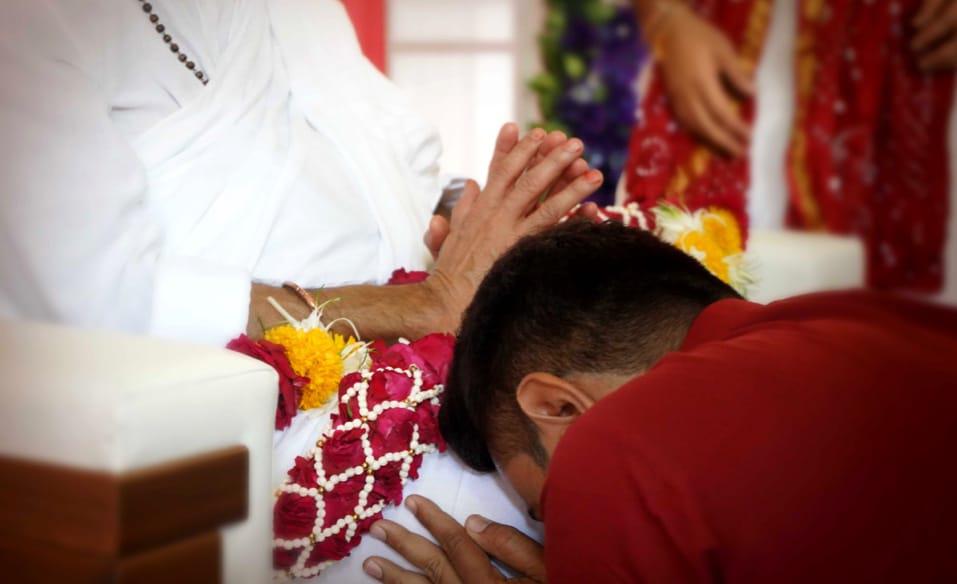
The evening before the satsang shibirs in the Dharampur Ashram, you can get initiated into the Beejam, Ankuram and Parnam Dikshas by Pujya Gurudevshri. The Master also initiates devotees into these Dikshas, when He is on dharmayatras across the world.
Aspirants are bestowed with Vanprastha Diksha by Pujya Gurudevshri during the Diwali shibir at the Ashram.
Atmarpit Diksha

Initiated into a life of spiritual pursuit, selfless service and absolute surrender, the Atmarpits are a group of life-long celibate devotees. The Atmarpit Training Programme is a two-year course for aspirants wishing to embrace Atmarpit Diksha.

